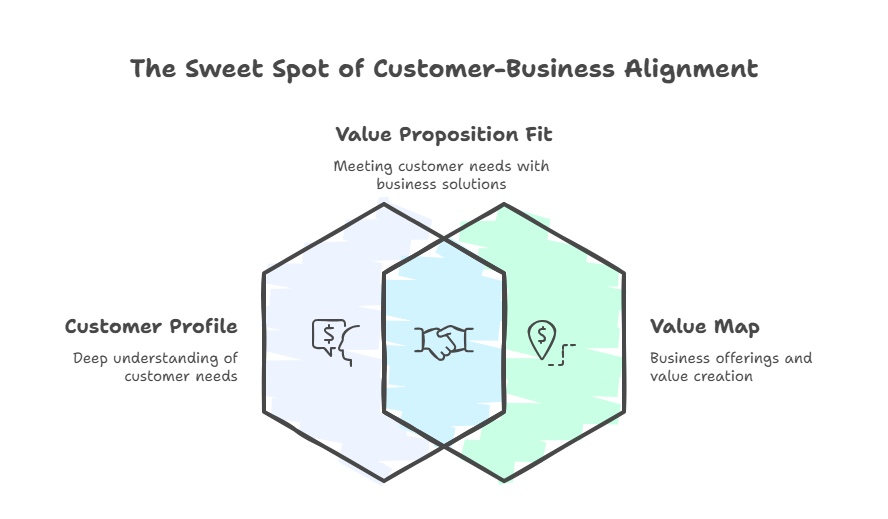What is Value Proposition Canvas? A Complete Guide
Learn how the Value Proposition Canvas helps businesses align products with customer needs through pain relievers and gain creators for better market fit.
What is the Value Proposition Canvas?
The Value Proposition Canvas is a strategic management tool that helps businesses ensure their products or services are positioned around what customers truly value and need. Developed as part of the broader Business Model Canvas framework, this visual tool creates a clear connection between customer requirements and the value your business delivers.
According to Business Model Analyst, the canvas serves as a business model tool that helps ensure a company's product or service aligns with customers' values and needs. It transforms abstract customer insights into actionable business strategies.
The Two Core Components
The Value Proposition Canvas consists of two main sections that work together to create customer-business alignment.

Customer Profile
The right side of the canvas focuses entirely on understanding your customer. This section breaks down into three key elements:
- Customer Jobs: What customers are trying to get done in their work and life
- Pains: Negative emotions, risks, and obstacles customers experience
- Gains: Benefits and outcomes customers want to achieve
As B2B International explains, achieving fit between the value proposition and customer profile happens when your products and services address the most significant pains and gains from the customer profile.
Value Map
The left side details how your business creates value through:
- Products & Services: What you offer to customers
- Pain Relievers: How your offering alleviates customer pains
- Gain Creators: How your offering produces customer gains
Medium contributor Vaughan Broderick describes the Value Proposition Canvas as a tool to visualize how a business creates value for customers specifically through pain relievers and gain creators.
Why the Value Proposition Canvas Matters
Using this framework provides several strategic advantages for businesses and product teams.
Aligns Products with Customer Needs
The canvas forces you to think from the customer's perspective first, then design your value proposition accordingly. This customer-centric approach prevents the common mistake of building products based on internal assumptions rather than real customer needs.
Mooncamp emphasizes that the Value Proposition Canvas plays a crucial role in business success by aligning products and services with customer needs. Proper use can help avoid common pitfalls and lead to higher customer satisfaction.
Creates Clear Value Fit
The ultimate goal is achieving value fit—when your products and services perfectly address the most important customer jobs, pains, and gains. This fit becomes the foundation for sustainable competitive advantage and customer loyalty.
Enables Continuous Improvement
The canvas isn't a one-time exercise. As Mooncamp notes, neglecting to iterate is a common pitfall. You should continuously refine your Value Proposition Canvas based on customer feedback and new market insights.
How to Create Your Value Proposition Canvas
Follow this step-by-step process to build an effective Value Proposition Canvas for your business.
Step 1: Map the Customer Profile
Start by deeply understanding your target customer. Conduct customer interviews, analyze support tickets, and review market research to identify:
- What jobs are customers trying to accomplish?
- What frustrations and obstacles do they face?
- What outcomes and benefits do they desire?
Be specific and evidence-based rather than relying on assumptions.
Step 2: Design the Value Map
For each element of the customer profile, design corresponding elements in your value map:
- Create pain relievers that directly address customer pains
- Develop gain creators that deliver desired customer gains
- Design products and services that enable both
Step 3: Achieve Value Fit
Evaluate how well your value map addresses the customer profile. Look for gaps where important customer pains remain unaddressed or where you're investing in features that don't correspond to significant customer gains.
The Interaction Design Foundation explains that businesses and designers use the Value Proposition Canvas to analyze, evaluate and adjust their value proposition, ensuring it remains relevant and compelling.
Practical Applications and Benefits
The Value Proposition Canvas delivers tangible benefits across various business functions.
For Product Development
Product teams can use the canvas to prioritize features based on their impact on customer pains and gains. This prevents feature bloat and ensures development resources focus on what matters most to customers.
For Marketing and Sales
Marketing teams can craft more compelling messaging by directly linking product benefits to specific customer pains and gains. Sales teams can use the framework to demonstrate clear value during customer conversations.
For Strategic Planning
Executives and strategists can use the canvas to evaluate new business opportunities, assess competitive positioning, and identify areas for innovation.
Visualizing Your Value Proposition with ClipMind
Creating and iterating on your Value Proposition Canvas becomes more effective when you can visualize the connections between customer needs and your value proposition. ClipMind offers powerful mind mapping tools that help you build and refine your canvas collaboratively.
The Value Proposition Canvas transforms abstract customer insights into a structured framework for creating compelling value. By systematically addressing customer jobs, pains, and gains with corresponding products, pain relievers, and gain creators, businesses can achieve the product-market fit that drives sustainable growth and customer loyalty.
 ClipMind
ClipMind